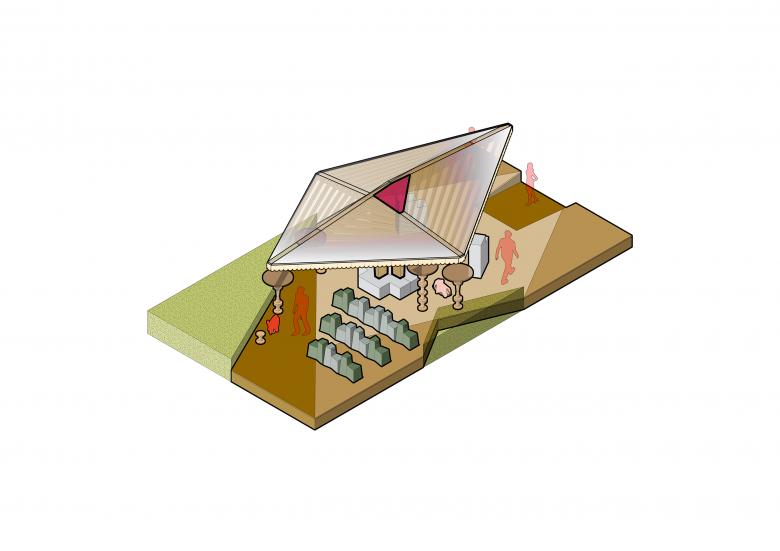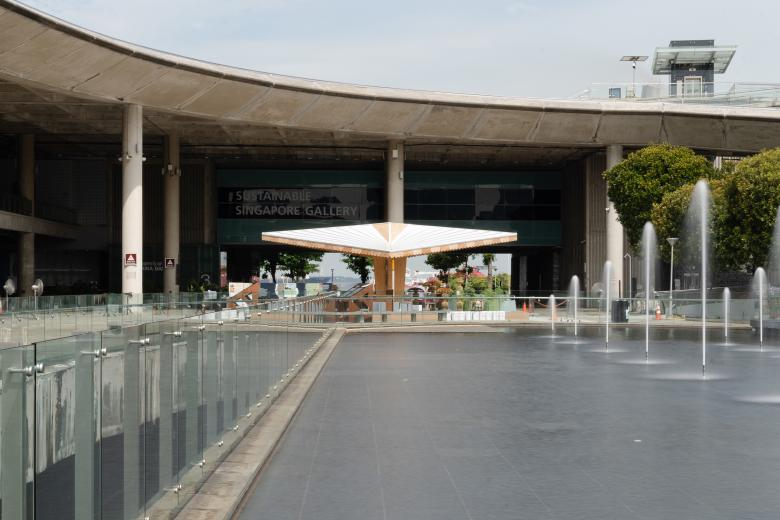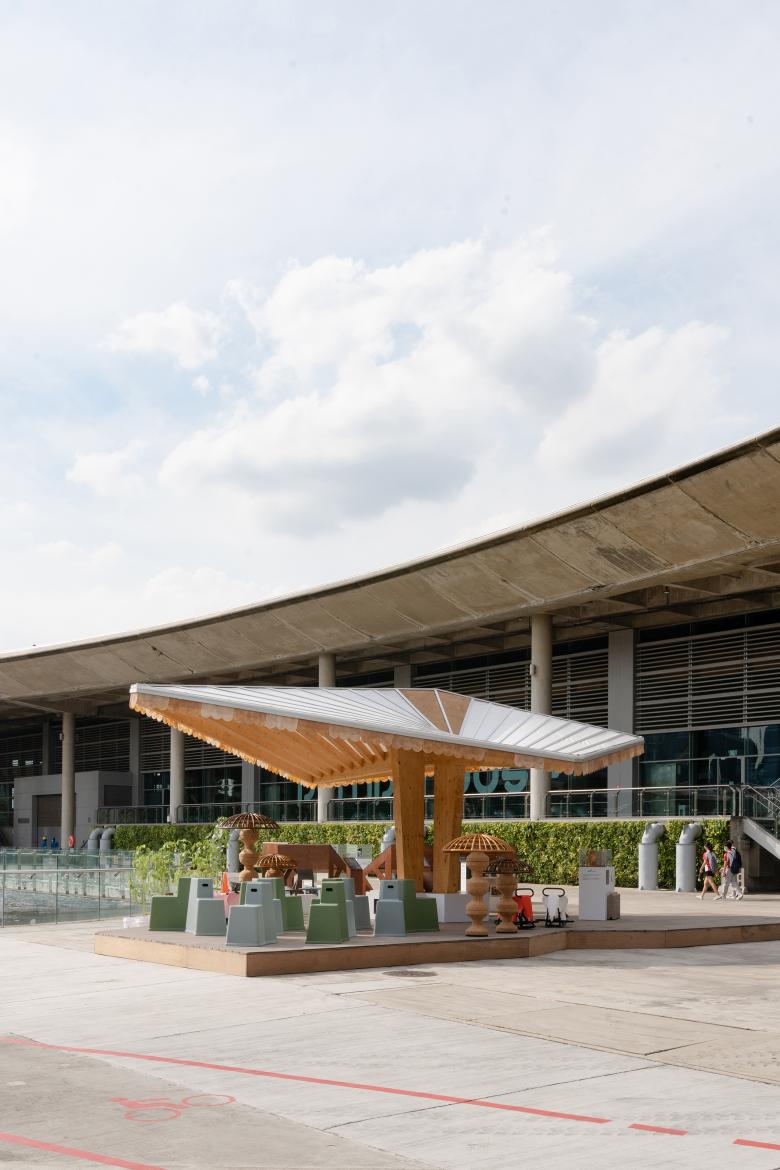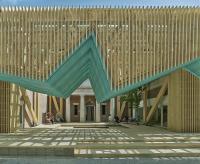+Pavilion
Singapore, Singapore
The Swiss cross inspires the structural concept of a glue-laminated timber pavilion showcasing a vignette of a sustainable built environment.
+Pavilion highlights the urgency to reduce the carbon footprint of the built environment – an important action that is part of Singapore’s Green Plan 2030 – and the ways industry players can do so.
The built environment of every city and country in the world is collectively responsible for 39% of global carbon emissions, of which 11% is embodied carbon and the remaining 28% is from building operations. Embodied carbon is the carbon released during the manufacturing, transportation, and construction phases of a building. This means that 11% of global carbon emissions are not recoupable once buildings are constructed [1].
Hence, sustainability and circular design techniques must be key priorities from the start of the building design and construction process, in order to effectively reduce the carbon footprint of the built environment.
Designing sustainable buildings requires more efficient construction methods, and the prioritization of the reusability and the durability of buildings and building materials. +Pavilion presents several methods that can reduce the embodied carbon emission of buildings:
+Pavilion is based on modular design and construction with pre-fabricated, pre-assembled modules, and ‘fit-for-purpose’ services.
The +Pavilion architectural and structural form was inspired by the Swiss cross. Two ‘nested’ sets of tapering columns and purlins members sprout from this geometry to form the 5m cantilevering supports for the ruled surface roof form. The main structure is made from Swiss glued-laminated timber (glulam) fabricated by a 5-axis CNC machinery which has also enabled subtly rotational curved roof rafters members to be fabricated. The single module manifested in this pavilion is only part of this geometrical tessellation. Two sets of triangulations are conjoined in a diamond configuration, forming a 120 degrees angle at the pair of lower opposite roof ends. This configuration allows three modules to form a sizable shelter and infinitely proliferate itself into a woven shelter tapestry.
The Glulam structure is counterweighted by a pre-fabricated reinforced concrete panel. The interface is done via innovative anchoring and glued-in rod connections. The floor expands from there into a platform that consists of a modular off-site bolt & nut system, which avoids the otherwise energy intensive welding works. The modularity provides design flexibility to create a wide range of engineered structures, and the pre-fabrication allows precision manufacturing unimpacted by inclement weather. Both lead to more standardized and efficient assembly, translating to overall savings on building construction cost. The bolted modular supports significantly reduce carbon steel usage, enabling carbon footprint reduction, and reuse for future modifications. On top of the floor base, we are using timber composite floor panels that we upcycled from another project where they previously served their first life-cycle already.
Other materials consist of innovative biocomposite made from the Kenaf plant as parts of the roof and boards made of recycled coffee serving as exhibition signage. It is the first time in Singapore that Kenaf (also known as Hibiscus cannabinus L, a rapidly grown tropical multipurpose plant) biocomposites are being explored as roofing components such as reinforced central skylights and rain eaves.
The +Pavilion is designed to attract attention, and encourage engagement with fellow visitors. The furniture on the pavilion, while providing a place to sit, relax, and interact, were curated to demonstrate different aspects of sustainability, from natural to recycled materials. Cork and rattan furniture are creatively used to highlight natural materials and demonstrate the capabilities of recycled polypropylene, composed by a mixture of recycled household waste. Multiple workshops and gatherings are planned to drive more discourse around sustainable building design and construction as part of the +Pavilion program at Marina Barrage.
While the installation in itself is a piece of showcase, complementary exhibition signage provides deeper insights into the story of the pavilion and education on sustainability
+Pavilion symbolizes the ‘sum of parts’ approach that is needed to tackle climate change as a whole: starting small, coming together as an ecosystem, and collaborating to turn ideas into reality. This project is just the beginning of something bigger, a showcase of our hopes to transform the way we build.
[1] Source: Embodied carbon call to action report | World Green Building Council (worldgbc.org)
- arkkitehdit
- Studio SKLIM
- Location
- 8 Marina Gardens Drive, 018951 Singapore, Singapore
- Year
- 2022
- Client
- Embassy of Switzerland in Singapore
- Team
- Kevin Lim, Ashwin Bafna
- Partner / Kenaf Specialist, Kenopy with Studio SKLIM
- Affordable Abodes
- Partner / Exhibition,Communications,Curation
- Deloitte (Singapore)
- Partner
- EHL Campus (Singapore)
- Partner / Glulam Timber Technology & Fabrication
- Haring Timber Technology
- Partner/Specialist Modular Platform
- Hilti
- Partner
- Marina Barrage
- Partner
- Nespresso
- Partner
- UBS
- Partner / Furniture
- Vitra
- Exhibition Design & Fabrication
- HAM Creations
- Structural Engineer
- Keon Consult
- Fabric Roof
- Pleo Cre8tions
- Main Contractor
- TopZone E&C






























